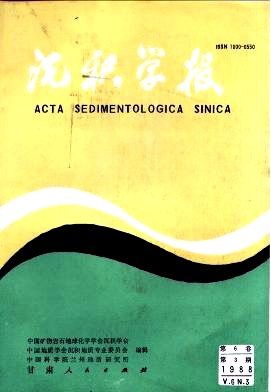A STUDY ON THE DOLOMITITE OF HUANGLONGGROUP, MID-CARBONIFEROUS IN REGION OFWESTERN JIANGXI PINGLE TROUGH
- Received Date: 1986-07-15
- Publish Date: 1988-09-10
Abstract: Concerning the origin of dolomitite of Huanglong group of Mid-Carboniferous in Western Pingle trough, according to feild geological research, determination under pol-arizing microscope, analysis of common elements and O, isotopes and so on, this article consider that dolomitite was not the result of primary sedimentation but of metasomatism. However, the diffeerences among textures, structures and the various gentic types of dolomitite represented different mechanisms of origin. According to the size of crystal and the difference of textures and structures of dolomite, dolomitite can be sorted into two main genetic types. 1 . Parasyngenetic dolomitite Micritic dolomitite, powder crystal dolomitite, algal micritic dolomitite, algal laminated bedding dolomitite are the mainly rock types in which always can be seen such sedimentary characteristics as bird-eyes, contraction fissures, burrows and salt karst structures, the sedimentary environment showed to be a hot, dry and a high evaporation rate tidal flat. Micro-silt crystalline, xenomorphic granular textures can be seen under electr-on-scanning-and polarizing microscops. This kinds of dolomite stands for the feature of parasyngenetic dolomitite under fast diagenesis in the hypersaline sea water environment. 2. Diagentic dolomitite The main rock types is fine-coase crystalline dolomitite intercalated by irregular thin bedings of micritic dolomitite and algal micritic, yet can be seen huge-crystalline dolomitie above the section. The sedimentary characteistics mainly horizontal burrows and beddings, bird-eyes and contraction fissures can be seen in micritic and algal laminated bedding dolomitite. organisms are comparatively rarely. The sedimentary enviroment is tidal flat lagoon. The fine coares crystalline texture. idiomorphic extent slab-rhombic crystalline, and the fogcentre ring-basnd, not only revealed a salty changing environment but alsobe important signs of diegenetic dolomitite. This kind of dolomite wa of the feature of diagenetic dolomitite of sluggish crystallization. Through the analysis and study, the author discovered that trace element-Sr and δ18O and δ13C isotpes values of micro silt crystalline and fine coarse crystalline dolomitite have evident discrepancy, sepecially δ18O and δ18C isotops values in this region. This reflected that dolomitites were formed in different sedimentary ( diagenetic ) environments and diaentic stages, it is a supplementary sign to analysis the origin of dolomitite. In this the paper the author proposed two models of dolomitite origin which may be apipled in this region. 1. The dolomitite model of hypersaline sea water The Hypersatine sea water sink into sediment because of it's solution weight. So the Ca cationes was replaced by Mg cationes and dolomitization have taken place in the carbonate sediments, followed that formed dolomitite of micro-silt crystalline. 2 . The dolomitite model of the mixture water The mixing of fresh water ( underground water and precipitate water ) and the sea water of hypersaline ( or normal sea water ) , taken place in the flow zone of underground fresh water. These conditions favoured the replacement of dolomitite because the salinity droped drastically and the Mg/C ratio changed less in the pore-water, formed dolomitite of coarse crystalline.
| Citation: | Yu Zhiwei. A STUDY ON THE DOLOMITITE OF HUANGLONGGROUP, MID-CARBONIFEROUS IN REGION OFWESTERN JIANGXI PINGLE TROUGH[J]. Acta Sedimentologica Sinica, 1988, 6(3): 60-69. |






 DownLoad:
DownLoad: